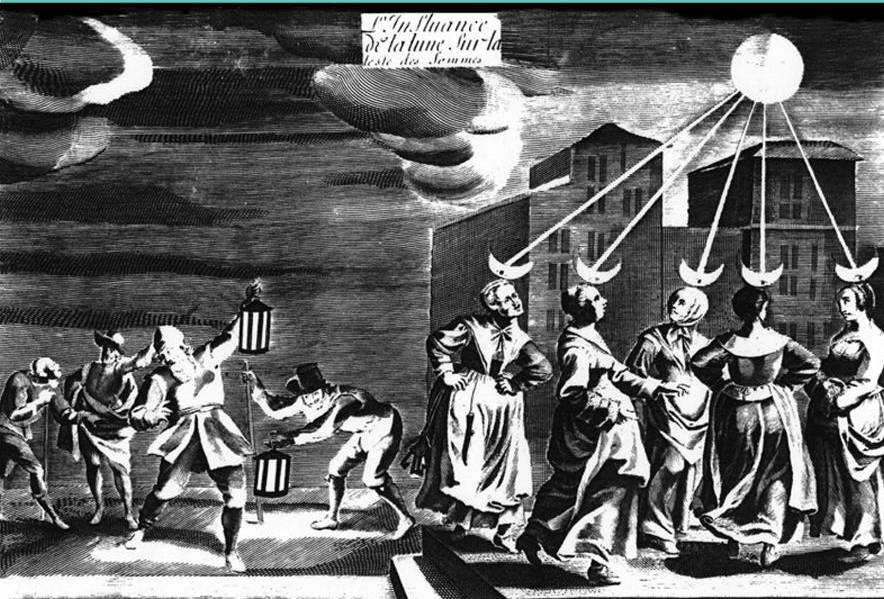Lunatics: Men, Women and the Moon in Early Modern France
By Tom Porter
Renaissance astronomers, medical doctors, and laypeople saw the moon as a force to be reckoned with, whose power extended not only to the tides, but regulated the flow of all things wet on earth, including bodily fluids. Women, with all their gender-specific liquidities and their menstrual cycle that mirrored that of the moon, were thought to be particularly susceptible to lunar influence.
In a recent public lecture Associate Professor of Romance Languages and Literatures Katherine Dauge-Roth examined how early scientific ideas about the physiological influence of the moon on women became a popular trope in the debates over male-female equality that raged in France throughout the early modern period. Professor Dauge-Roth specializes in sixteenth- and seventeenth-century France and has published articles on mysticism, demonic possession, graffiti, and criminal branding in that period.
Dauge-Roth’s interest in early modern medicine and gender led to her current project, Lunatics: Men, Women and the Moon in Early Modern France. Dauge-Roth delivered a public lecture on the subject April 14. It was presented as part of the Medieval and Early Modern Studies ‘Science Before Science’ colloquium.
She spoke with College Writer and Multimedia Producer Tom Porter.
Click here to listen to the interview (audio may take a few seconds to load):
Edited interview transcript:
Tom Porter: Explain the meaning of the term “lunatic” and how it’s changed
Katherine Dauge-Roth: In French the meaning of the word hasn’t changed that much. The word comes from “luna”, the Latin for moon. So the idea was that these were people who were changing with the moon, changing their moods, their behaviors. And in French you still talk about somebody who is “lunatique”, as an adjective or a noun, as someone who is changeable and temperamental. And the term gets used for both men and women, but in particular perhaps for women.
TP: Whereas in the English language, “lunatic” is just a general word for someone who’s crazy?
KDR: Yes, someone who acts crazy: for example “the lunatic drove me off the road.” But we’ve lost that sense of a lunatic as a moody person.
TP: The lecture refers to “men and women” but you’re mostly talking about women who are affected by the moon aren’t you?
KDR: For the most part, it is women who in 16th-century medical discourse were considered to be affected by the moon, in relationship with the moon, following the moon’s course of 28 days through their menstrual cycle. And so this medical idea that was very prevalent in the 16th century gets used in popular discourse to talk about women as changeable, therefore unable to pursue learning, unable to assume positions of leadership because you don’t want someone who’s changing all the time.
TP: And this is all played out against the backdrop of the battle of the sexes that was raging in early modern France. Tell us about that.
KDR: Absolutely. We call it the “querelle des femmes” in French, but it’s more accurately described as a battle of the sexes because it’s going back and forth between men and women, between defenders of women and critics of women. The women in the 17th century, in France in particular, were assuming greater roles. They were part of the intellectual circles investigating new science, they were on the battlefield dressed as men during revolts like “La Fronde”, the civil war in France in the 17th century. They took on major positions as arbiters of intellectual life, they had “salons” where they would invite the biggest thinkers of the time to come and give demonstrations. So these women who get ridiculed later as “Les Precieuses” – the precious women I guess you might say – were actually defending women’s rights to make their own choices about marriage, to make their own choices about their reproductive rights.
TP: And these were women who would have to be wealthy in those days to pursue that?
KDR: Yes. We’re mostly talking about aristocrats or upper-class bourgeois.
TP: You’ve talked about how the moon was used as a trope to criticize women as being unstable. How did some of these early proto-feminists use this moon imagery in their own defense?
KDR: I have an example. One text in particular that I was excited to find was by a woman named Charlotte de Somaise de Chazon, Countess of Bregy. She was an aristocrat, and very much in the inner circle of Anne of Austria, one of her ladies in waiting. A real arbiter of intellectual life at the court, she wrote a text in which she took the image of the lunatic woman and used it to perform her own social critique: first of women, interestingly enough. Not of her own friends, who she said were exempt from the influence of the moon, but she criticized all kinds of other women and their bad behavior. But then a year or two later, she writes a companion volume to that text that is all about men, and how men are influenced by the moon. So she’s taking this trope and turning it on its head and saying “men are just as receptive to lunar influence as women, and these are all the ways that they behave badly.”
TP: Was there a way in which the connection of females to the lunar cycle was viewed as a good thing?

KDR: It was a positive thing in 16th century medical discourse. This was an age before ovulation was known about, when we didn’t understand why women menstruated every month. The medical doctors and astrologers – astrology is still very much a part of medicine during this period – felt it was a very healthy thing for women to purge every month, to get rid of the bad blood, and to stay regular. So it was seen in a positive way in the 16th century. And even as scientific understanding progressed into the 17th century, the idea of women being associated with the moon remained a popular idea.
TP: From the perspective of 2016, what are the key lessons we can learn from this topic today?
KDR: I was struck when I did a google search on “femmes lunatiques”, or lunatic women, to find how many references there were to women as being changeable and flighty, and difficult for men to understand and to control because they change all the time. And I think that’s a popular idea that remains very prevalent today around women. Men talking about “how do I deal with my wife during her time of the month?” I mean our students are still talking about this.
Katherine Dauge-Roth is Associate Professor of Romance Languages and Literatures at Bowdoin. She teaches courses in the Francophone Studies program at Bowdoin ranging from French language and Contemporary France through the Media, to upper-level literature and culture courses that connect the early modern to today.



